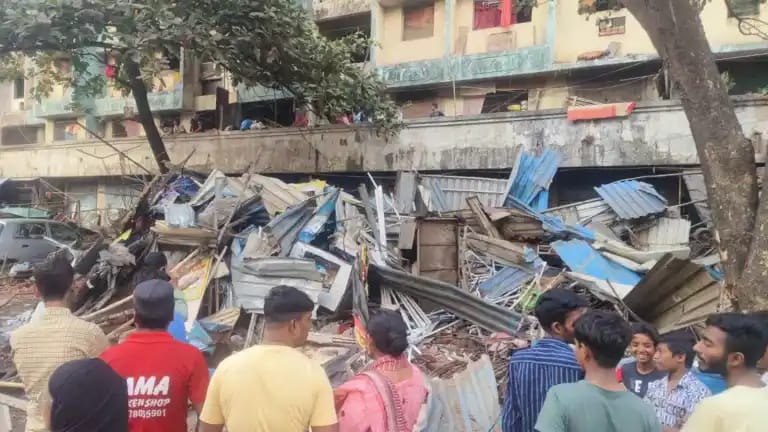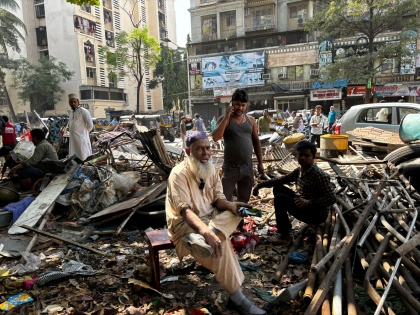– Shayma S
Why are there a Naya Nagar and a Mira Road in Mumbai, the cosmopolitan city of dreams; why are well-off Muslims moving back into Jamia Nagar from the affluent suburbs of Delhi NCR, and why is there a Mumbra – 28 kms from Mumbai – or a Juhapura – a vast subcity of Muslims – after all? On social media, Hindutva supporters took to argue that in “Hindu Rashtra” (the arrival of which is repeatedly announced, the latest arrival being the consecration ceremony), there cannot be a Mira Road or a Muslim ghetto. According to one account, Mira Road is a “ghetto township of Bangladeshis and Rohingyas.” The post claims that they have Aadhar cards from West Bengal and are taking over the local hawker business. Others write that “Naya Nagar is more Pakistan than Pakistan itself”. However, primarily, the concern is that there should be ‘no place’ for a ‘Muslim area’ in India.
Mira Road witnessed Hindutva violence on the day of the Ram Mandir consecration, with deliberate provocations that have now become a norm like the Ram Navami incidents of last year. Mira Road, officially a suburb north of Mumbai in Thane district and part of the Mumbai Metropolitan Region is split into Naya Nagar and Shanti Nagar, the latter of which is primarily Hindu-dominated and where Muslims find it difficult to get houses on rent, a feature common to many other such enclaves in cities like Delhi as well. However, Naya Nagar is also home to a very diverse population, with different religious communities coexisting peacefully, including those of Hindus who do not face persecution from the Muslim majority population. How, then, is Naya Nagar – a ghetto – seen with such negativity and stereotypes, but Shanti Nagar – or the elite colonies of Delhi that do not give houses on rent to Muslims – not treated as exclusionary realms?
What is a ghetto? Drawing from Loïc Wacquant, Christophe Jaffrelot and Laurent Gayer define the ghetto as a “a bounded, ethnically [or religiously] uniform sociospatial formation born of the forcible relegation of a negatively typed population.” (p. 21)
As seen in studies like that of Juliette Galonnier (2014), there are primarily three kinds of segregated spaces – ghettoes, which stem from constraint; the enclave, which accounts for more intentional segregation; and the citadel, which is a deliberate attempt to exclude what are seen as undesirable populations (think elite gated colonies with heavy policing against outsiders, and a high level of hierarchy even between residents and staff).
Other studies have also included the ‘slum’ – as a category, again driven by compulsion and the arrangements of labour needs in large cities that require a ‘slum’ to be attached to high-end colonies and posh residential areas to provide them with free and accessible labour. Dharavi in Mumbai is a major example.
In short, to quote Susewind (2017, p. 1288), “If an ethnic group is relegated to certain neighbourhoods we speak of a ‘ghetto’; if poor people are forced to club together we see a ‘slum’; if an ethnic group voluntarily chooses to segregate, they form an ‘enclave’; and if rich people isolate themselves, this constitutes a ‘citadel’.
In India, Muslims find their choices much more constrained, with even better-off Muslims finding it difficult to find houses on rent or a safe environment to live. What are seen as ‘enclaves’ are primarily products of state-sponsored violence and impunity. Religious segregation is a norm and has also been a cause for concern in India. Those who think Muslims ‘choose’ to live in ghettoes argue that they are, in fact, enclaves, thus arguing that Muslims practice self-segregation. This is reflective (in a more academic way) of the arguments found on social media websites. However, how many Muslims can freely exercise residential choices, and how have large ghettoes like Juhapura or Mumbra formed?
A brief reading of contemporary history will tell you that residents of places like Naya Nagar are already displaced and have been victims of insecurity. Pushed out after the Bombay riots, ghettoes like Mumbra are the results of impunity and absolute apathy. They cannot be seen as enclaves because that would indicate that they chose the entire process freely. State negligence is ignored in this entire argument.
As Rubina Jasani (2007) has also argued, in the context of Gujarat and the forceful closure of relief camps, Muslim survivors of violence were left with few options – moving back to their original place of residence, which was often not an option for them as they did not want to live in the same insecure places where they faced attacks or to move into larger Muslim areas in the city. Eventually, Muslims moved to the peripheries or areas outside municipal limits. This process of forced migration due to violence began much earlier than 2002, as Shailaja Menon and Jestin Joji in their 2023 study show (p. 170) , that “After the violence of 1969 [in Ahmedabad], a steady flow of migration began as people moved to other ‘safe’ spaces within the city as their homes and shops became targets of riots.”
However, the most widespread violence was indeed that of 2002. In two significant areas, state discrimination became visible: the announcement of financial compensation and the state’s presence in the relief camps set up post-pogrom. Not only did the state give Hindu Godhra victims more relief, but they also provided fewer amenities to the Muslim-majority camps. This set in process the slow churn of rampant segregation and ghettoisation. They argue (p. 172) that the pogrom was “…the final nail in ghettoisation of Juhapura when the elites and upper-class Muslims living in the posh localities in the western part, who were unscathed in the previous riots, chose to migrate to regions of Muslim majority due to the horrific nature of the riots.”
Similar patterns can be seen in other cities like Mumbai and now, Delhi, where even if Muslims can afford to live in better areas with civic amenities, they face many difficulties, including lack of housing options, higher rent, insecurity of living and discrimination as well as rampant surveillance.
These ghettoes then begin to attract negative criticism and are seen as ugly, dangerous and threatening distractions from the growing cosmopolitan city. This phenomenon of blaming is also not limited to Muslims; as Sumeet Mhaskar (2018) has shown, both Muslim and Dalit residential areas are seen as unclean, which is the result of inferior municipal services provided, not any intrinsic trait of the communities.
While many areas may be Hindu-dominated citadels that do not allow for others to find a place there, they cannot be equated with ghettoes because they are not affected by stigma, shunning and fear. They actively exclude communities, while in so-called “Muslim ghettoes”, you will find a diversity of people co-existing, as in Mira Road, which is home to a vast Christian population as well!
Even the Hindus who moved out of Mumbra as the Muslim population increased with waves of forced migration after each incident of violence in Mumbai, primarily did so due to their discomfort with the changing demographics, and not any threats of violence or isolation, as Raksha Kumar has traced in her study on the blossoming literary scene in Mumbra in the aftermath of the CAA-NRC protests.
As Radhika Gupta writes (2015), “[The] essentializing and othering of Muslims came to be expressed in spatial terms in postcolonial India.” Muslims began to be seen as internal enemies, and consequently, so are their places of residence. Stereotypes about terror, the frequent azaan, meat shops and other such symbols of Muslim urban life have shaped the dynamics around ghettoes without ever understanding the humanity present within them and their traumatic histories.
Despite the lack of suitable housing, schools or public hospitals, Muslim ghettoes have managed to survive. The tourists who arrive every Ramadan season to experience ‘food culture’ in areas like Old Delhi do not pay much attention to the deeper realities of ghettoization in India, which, as scholars of urban sociology like Professor Ghazala Jamil have argued, is not a voluntary phenomenon at all.
In an article in Sabrang, aptly titled “Theirs and Ours”, researcher Sabah Maharaj writes that “Children growing up in SC and Muslim neighbourhoods face disadvantages compared to those residing in non-marginalized neighbourhoods within the same cities. This disparity holds true even for non-SC non-Muslim children residing in SC and Muslim neighbourhoods. For instance, a child growing up in a neighbourhood with 100% Muslim population can expect to receive two fewer years of education compared to a child in a neighbourhood with no Muslims.”


Instead of addressing this state apathy, bulldozers are trawling over Mira Road to demolish twenty-year-old garages and hotels serving thousands of people. This brutal and swift injustice, on top of religious provocation, has left the residents of Mira Road exhausted and weary. Doubly, even triply displaced over the decades, they wonder if another migration is on the charts.
The misinformation about ‘Muslim areas’ and ghettos on social media is not new. However, it is particularly egregious to argue that there should be no ‘Muslim areas’ in this new, modern India when Muslims do not have access to ‘other’ areas that appear open and neutral at first glance but, in reality, are the perfect examples of self-segregation and exclusion that Muslim areas are falsely accused of being.




